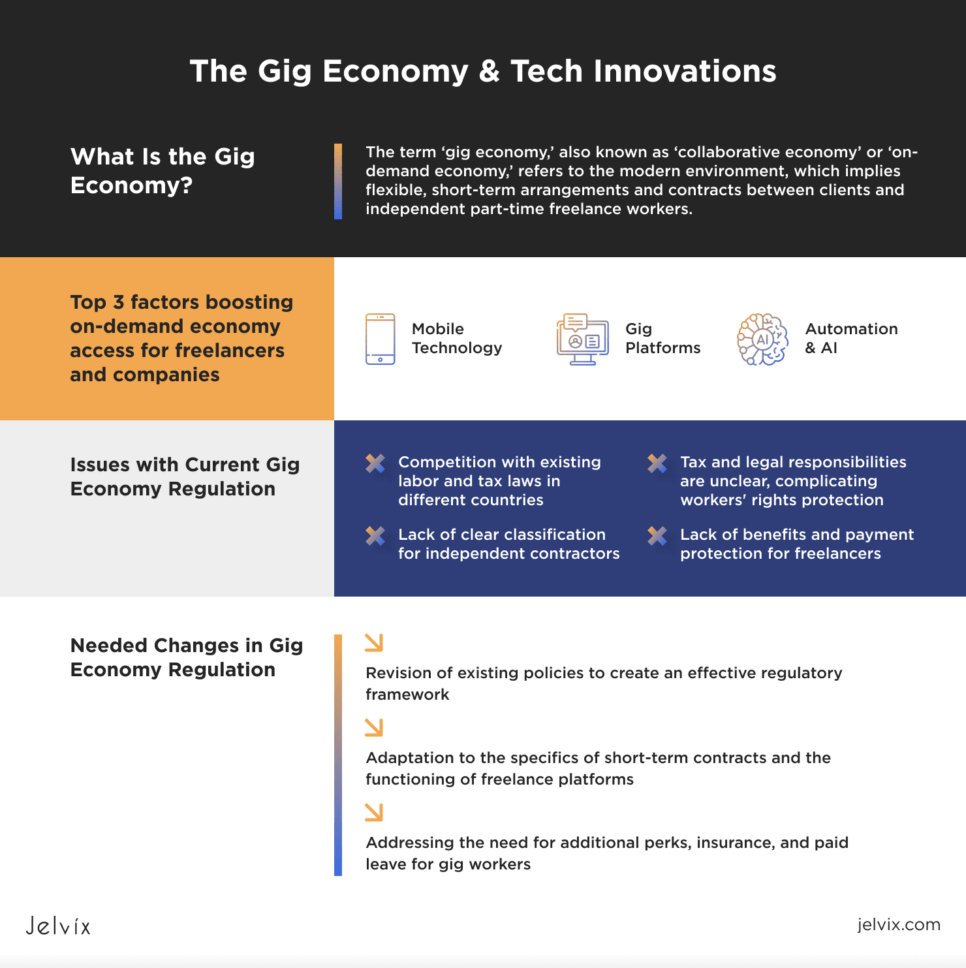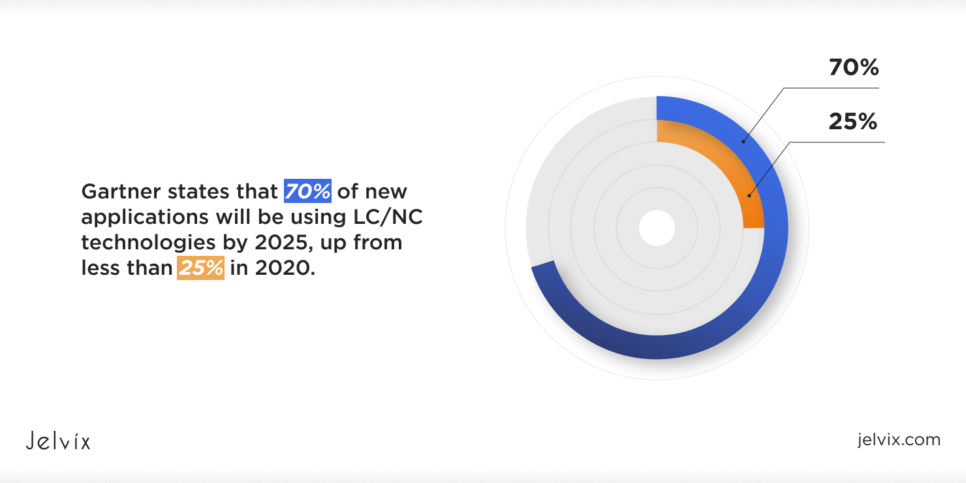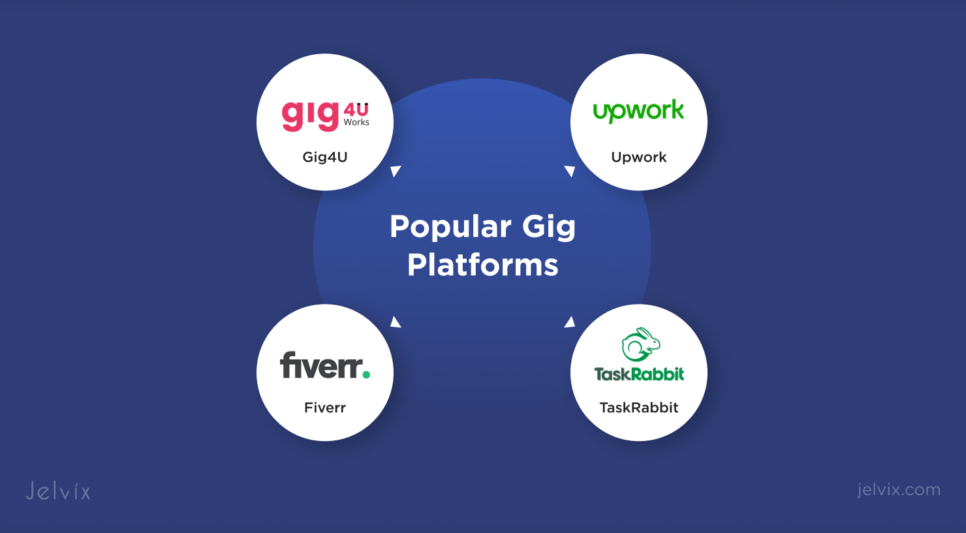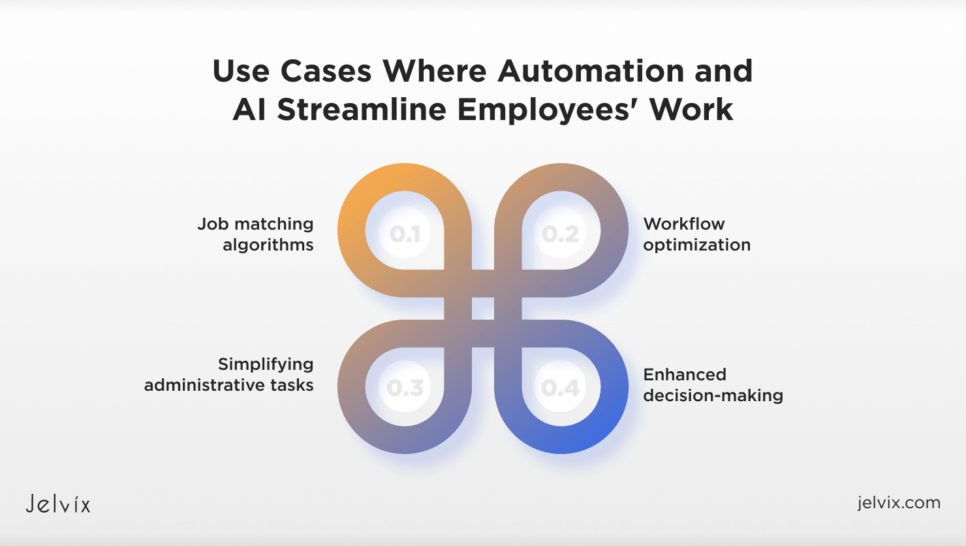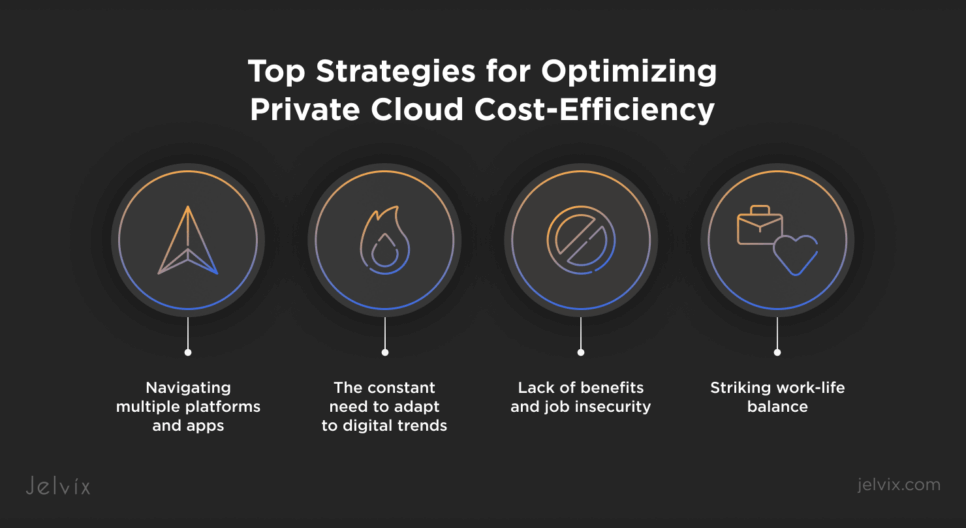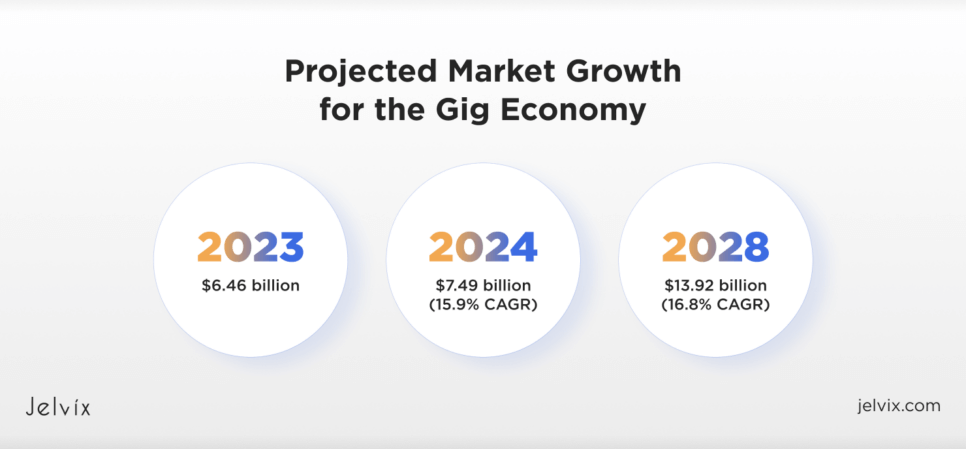The ‘gig economy’ has become a buzzword these days. Its impact is growing every year. Individuals, as well as small, medium, and large businesses, use its services. Technological advancements support the on-demand economy’s growth, providing its participants with the necessary convenience, flexibility, high-quality services, and earning opportunities.
This article will examine the collaborative economy and how innovations have changed the part-time job market. We will also discover the role of tech giants in this sphere and outline challenges and further trends that will describe this environment in the future.
Let’s start with the definition of the gig-based economy.
What Is the Gig Economy?
The term ‘gig economy,’ also known as ‘collaborative economy’ or ‘on-demand economy,’ refers to the modern environment, which implies flexible, short-term arrangements and contracts between clients and independent part-time freelance workers. A good example is ride-sharing services such as Uber and Lyft. Drivers who cooperate with them work part-time and receive fees for rides.
Today, there is a formed stereotype that a gig job can only be remote. But gig work is not always performed remotely. Plumbers and taxi drivers are excellent examples of the contrary.
Nevertheless, the disrupting impact of technologies has changed the job landscape significantly. People are easily connected online and perform their tasks on the web. Thus, with the latest technological advancements, the sharing economy removes barriers, including geographical and language ones. Its development was associated with many factors that influenced how this market looks now.
So, let’s analyze how the modern gig economy has evolved and developed over many years.
The Evolution of the Gig Economy
The on-demand economy emerged as the relevant answer for the 9-to-5 job model, jeopardizing employees’ work-life balance. The shift started in the 1970s because of economic and technological factors. They started to transform the traditional workplace. IT industry firms like IBM began to hire independent contractors for specific projects. They opened new possibilities to gig workers, offering more employment flexibility.
Later in the 1980s, this trend steadily grew until the spread of the Internet among millions of new users in the 1990s. The introduction of the World Wide Web to the general public drastically improved connectivity among people. Technological advancements in software development, computer manufacturing, and internet connection began to confidently erase borders between countries, enterprises, and end-users.
This technological development led to the creation of web services that foster communication between clients and contractors. So, the percentage of gig workers increased significantly because new platforms assisted in reliable communication, payment protection, and community support.
In 2019, the Bureau of Labor estimated that the percentage of workers in the gig economy in the United States would increase to 43% in 2020. Despite the pandemic, this number rose enormously in 2020. According to different studies by Manpower Group and Metlife, countries with a high percentage of young workers tend to search for freelance jobs more often than others. For instance, 97% of people from Mexico and India seek part-time jobs. In the US, 85% of workers consider staying in the gig-based economy for the next five years.
The on-demand economy continues to grow along with tech trends. McKinsey’s research “The Top Trends in Tech” estimates that 50 billion devices will be connected to the Industrial Internet of Things (IIoT) by 2025. Gartner states that 70% of new applications will be using LC/NC technologies by 2025, up from less than 25 percent in 2020. Statista forecasts worldwide spending on blockchain solutions will reach almost $19 billion by 2024.
Peter H. Diamandis and Steven Kotler, in their book “The Future Is Faster than You Think,” declare that the manifestation of technological innovations means we can experience more development in the next decade than in the past 100 years combined.
As you can see, the changes in the technological landscape have enormously influenced the gig economy. The following section will reveal which modern technologies have significantly impacted independent contractors’ domain over the past ten years.
Technological Advancements and Their Impact
The latest technological discoveries and trends have changed not only the gig-based economy but also the everyday lives of ordinary people. We all know what mobile phones, the Internet of Things (IoT), artificial intelligence (AI), and many other small and large innovations mean. Here, we have highlighted the top three impact factors influencing the on-demand economy, making it more accessible for freelancers and companies.
Mobile Technology
Mobile technologies represented by mobile communication, smartphones, and mobile applications provide access to new opportunities. They can connect independent contractors with clients in any part of the world. Gig workers can communicate, perform simple tasks, manage their scheduled projects, and receive payments with a few taps via smartphones or other mobile gadgets.
GPS has paved the way for ride-sharing companies like Uber and Lyft and home-sharing companies like Airbnb. Uber or Lyft drivers can trace the customer’s location and how they can reach the rider’s destination. Customers can call or text drivers to specify location details. Meanwhile, renters can easily find a home sharer because they can provide house location.
All such companies as Uber, Lyft, and Airbnb offer flexible job opportunities. For example, drivers can choose their schedule, work on their terms, and conveniently receive app payments.
Gig Platforms
Digital platforms and marketplaces play a pivotal role in the further expansion of the gig economy. Ultimately, such online services have become portals where freelancers and independent contractors can communicate with clients and conclude flexible short-term agreements. Gig workers can showcase their experience and skills within those platforms, and clients’ profiles provide necessary information for freelancers. So, gig platforms and marketplaces like Gig4U and Fiverr ensure the perfect match for both parties.
Let’s talk about a few gig portals that offer convenient services matching clients with independent contractors or freelancers.
Gig4U
This online marketplace is a leading platform for gig workers in India. It provides its services in 20,000+ cities. More than 28,000 freelancers are registered there. The platform offers flexible hiring solutions and transparent pricing without hidden costs. Specifics of this market is its local talent focus. Gig4U deals with local specialists and demand. Such flexibility facilitates faster turnaround within 24-48 hours for particular jobs.
Upwork
Upwork is one of the top freelance platforms worldwide. This US-based service has features such as milestone-based contracts and hourly tracking contracts, which can help gig workers get payment protection. Dispute resolution functionality also ensures smooth communication between clients and independent contractors.
The platform provides tons of valuable materials for freelancers to get started and scale. Community support allows gig workers to get answers to any questions that occur. Upwork has transparent pricing, security features, and other capabilities for reliable collaboration between clients and contractors.
Fiverr
Fiverr is one of the most popular marketplaces on the web for freelancers. Gig workers can showcase their skills and services while clients choose the proper candidate. The platform is convenient and has an understandable pricing model. The service enables gig contracts in various niches, including digital marketing, design, and software development.
TaskRabbit
This platform is a unique solution for part-time ad hoc jobs like moving assistance, handyman services, furniture assembly, cleaning, etc. TaskRabbit offers flexible job opportunities for skilled specialists selling their skills and experience to individuals who need a specific service.
Of course, there are many other freelance platforms and marketplaces, so we have mentioned only a fraction of them. However, information about how those services work can give you an idea of what the gig economy offers to satisfy customer demand. Be it software development, design, marketing, or cleaning services, freelance platforms bridge the gap between supply and demand and provide a comprehensive ecosystem that ensures better communication and collaboration between clients and contractors.
Let's discuss which IT outsourcing trends will change the industry.
Automation and AI
We all have heard those eerie stories where artificial intelligence (AI) steals human work in specific industries. However, as we can see, AI has become a great helper for various professionals.
With automation and AI, human productivity and efficiency have increased significantly. Below, you’ll find the most prevalent use cases where automation tools and artificial intelligence streamline employees’ work.
- Job matching algorithms: Intelligent AI algorithms can effectively analyze profiles of gig workers with skills and experiences to match them with specific projects. Another instance is automated applicant tracking systems (ATS), which can parse candidates’ resumes to find the best match.
- Workflow optimization: Automation and AI tools analyze task patterns and suggest hints for improvement. Automation can also reduce time on repetitive tasks. AI and automation can be used for project management, collaboration, communication, and workflow enhancement.
- Simplifying administrative tasks: Freelancers use AI tools to reduce time spent on daily administrative tasks like scheduling, invoicing, and task management. This allows them to focus on improving their skills and learning new ones.
- Enhanced decision-making: Data analysis, AI predictive analysis, and forecasting assist in making informed decisions about the projects they seek and the prospects of specific niches.
Challenges in the Tech-Driven Gig Economy
Despite the advantages of the gig-based economy, which implies work-life balance, the ability to choose clients, locations, flexible schedules, and earning growth opportunities, there are numerous challenges to deal with. Let’s name the most significant of them.
Navigating multiple platforms and apps
Freelancers have a permanent need to offer their services on different platforms. They need to register and manage profiles and their work on multiple marketplaces. This practice is time-consuming and cost-increasing. Moreover, gig workers must deal with different systems and specific rules that can differ from platform to platform. Not complying with those regulations can lead to an account deactivation or termination.
The constant need to adapt to digital trends
Independent contractors must adhere to the latest digital trends, especially in digital marketing, software development, design, and project management. To become more competitive in the market, such freelancers need to spend part of their time researching better software solutions, the latest digital trends, and innovations that directly impact their niche. New tools require additional study, time, and money to develop new skills connected with new solutions.
Lack of benefits and job insecurity
Gig workers act as independent part-time contractors. So, they don’t have access to typical perks applied to any employee working full-time. Freelancers cannot apply for health insurance, paid leave, government retirement plans, and unemployment allowances. Short-term work means more insecurity because you can’t precisely plan your income a year ahead. Gig workers become vulnerable to financial instability and illness because of job insecurity and lacking extra gig economy benefits.
Striking work-life balance
Insecurity caused by low-income part-time jobs forces freelancers to seek more job opportunities. Applying to multiple jobs and performing many daily tasks jeopardizes the gig workers’ work-life balance. The dream of a flexible schedule can become a nightmare for them in a few months. Numerous deadlines weekly lead to emotional, physical, and even mental burnout.
The Role of Tech Giants
Tech companies regularly leverage gig platforms for talent acquisition and retention. Such services are a promising environment for tapping into highly skilled workers with specialized skills and expertise. IT companies hire gig professionals who have mastered a few or several skills needed for specific projects. Hiring high-value, tech-oriented clients has become one of the top priorities for gig services. Platforms and marketplaces collaborate with tech enterprise clients and help them hire top talents who make a difference in the ever-changing tech world.
However, attracting and hiring an independent specialist is a challenging task. It requires a different strategy compared with traditional employees. Companies should focus on effective talent acquisition practices and building long-term relationships to increase efficiency.
Enterprises provide freelancers with work-life balance and skills development opportunities that help them to grow. Some companies offer paying taxes for a gig worker, paid leave, insurance, free training, workshops, software, and other benefits that refer to standard full-time employees. Gig platforms support transparent communication between the client and the freelancer and provide payment protection for both parties. Enterprises can initiate a transparent system of bonuses for successful or even exceptional job completion.
New technological methods of concluding agreements between tech companies and gig specialists have arisen. Blockchain has become such an innovation. It is one of the best ways to overcome the fear of the gig workers not delivering the result or clients not paying the agreed-upon price.
As an immutable decentralized ledger, blockchain ensures safe and rapid transactions between counterparts. With blockchain technology, clients and freelancers can agree on unchangeable contracts, verify credentials, and complete reliable and seamless transactions.
Future Trends
The gig economy market size will rise in the coming years. According to the latest Freelance Platforms Global Market report by The Business Research Company, the freelance platforms market size will grow from $6.46 billion in 2023 to $7.49 billion in 2024 at a compound annual growth rate (CAGR) of 15.9%. In the next few years, it will grow to $13.92 billion in 2028 at a compound annual growth rate (CAGR) of 16.8%.
Harnessing new technologies and innovations that improve connectivity, security, and skills growth is also a distinguished trend. Among the most popular advancements, we can highlight artificial intelligence (AI), augmented reality (AR), and virtual reality (VR). They disrupt current work environments and provide new possibilities for skills development, collaboration, and leveraging innovations.
The impact of technologies on the gig market is constantly growing. Automation and AI reduce the number of repetitive tasks. Machine learning, a subset of AI, helps in data analysis and forecasting. Clients are more likely to value freelancers with creative, problem-solving approaches and emotional intelligence than others. The gig-based economy successfully competes with the full-time job market, providing flexibility opportunities for each member.
Gig platforms are also becoming more intelligent using AI matching tools that assist in hiring a suitable candidate for the project. The gig job market tends to expand, involving other niches like healthcare, education, and professional services.
Emerging niches may require regulatory compliance. Gig services should account for the specifics of certain domains. Competition between gig workers in such niches results in the high-quality services they provide their clients.
So, gig platforms and marketplaces will become more sophisticated, implying scalable and seamless software development solutions based on new technologies such as blockchain, AI, and AR.
Social and Economic Impacts
Remote jobs have become a helping hand for low-income regions. Companies from developed countries can leverage the cost efficiency of gig talents from developing countries. Freelancers from such countries as India, Pakistan, Bangladesh, and Nigeria offer services at lower rates than in the USA and Great Britain. However, companies should consider the level of qualification in certain areas despite the promising rates they offer.
The need for migration and the demand for office space will also shrink because remote gig workers don’t always need to relocate to other countries or commute to work. Freelancers have multiple opportunities to earn more by applying for numerous projects. However, gig workers still cannot apply for benefits accessible to full-time employees.
The severe competition in the gig job market highlights the importance of continuous learning and improving skills necessary for particular projects. Self-development is also a cornerstone for a freelancer who wants to regularly land new clients, communicate efficiently with potential customers, and improve work-life balance. Continuous growth and learning lead to high-quality paid professionals who readily adapt to the constantly changing job market and in times of uncertainty.
Regulatory Landscape
The gig economy’s regulatory environment is complex. It competes with existing labor and tax laws in different countries. Sometimes, there is no proper classification for independent contractors in policies. Lawmakers may not classify them as employees. Because of this and other factors, freelancers don’t receive benefits and sometimes payment protection. It affects their rights, causes tax implications, and blurs companies’ responsibilities.
Existing policies concerning the gig-based economy should be revised to create an adequate regulatory framework that adapts to the specifics of short-term contracting work and the functioning of freelance hubs. These regulations should account for the need for extra perks, insurance, paid leave, gig workers, and their clients’ rights protection. They should also reflect classifications of independent contractors and the development of new professions and gig works. These changes will also affect both freelance platforms and gig workers, increasing costs for gig services that offer more security for independent contractors.
Conclusion
Technological advancements have revolutionized the gig economy. This sphere has been permanently developing, starting from the invention of the PC and the widespread internet connection to the emergence of various tools and platforms, mobile technologies, automation, and AI.
Automation, AI, mobile connectivity, and other innovative trends like AR/VR and blockchain alter the gig-based economy, streamlining freelance platform services and independent contractors’ performance. Working and constantly learning in an innovation-based environment has become necessary for gig workers and companies who want to stand out.
The future of the gig economy looks vivid. The need for remote freelancers will grow because enterprises, including well-known tech giants, harness the significant benefits of working with top gig talents. Overcoming regulatory challenges and job insecurity issues will also be the next trend in the coming years.
FAQ
How has technology changed the gig economy?
The on-demand economy has been transformed by technology, which has created platforms that enable immediate connections, simplify task organization, and improve the overall experience for gig workers. Advancements such as mobile technology, automation, and AI have simplified the process for gig workers to discover employment opportunities, interact with clients, and fulfill tasks effectively.
What challenges do gig workers commonly face in a tech-driven gig economy?
Gig workers frequently need help with issues like uncertain job stability, the absence of employment perks, and the requirement to manage several platforms and digital tools. Adapting to constantly changing technologies and managing a healthy work-life balance can pose challenges. However, such technology as automated payment systems and practical task management tools help overcome some obstacles.
How do gig platforms differentiate themselves from each other?
Gig platforms offer easy-to-use interfaces, effective matching algorithms, and ongoing technological improvements. They ensure that gig workers have positive experiences by facilitating smooth communication, ensuring secure transactions, and providing access to various job opportunities. Freelance services features assist gig workers in optimizing their efficiency and achieving tremendous success.
What role do tech giants play in the gig economy?
Major tech companies that partner with gig platforms introduce programs to assist gig workers and promote innovation, significantly influencing the gig-based economy. Partnerships between technology firms and gig platforms result in more excellent prospects for gig workers. Large technology companies frequently offer educational programs, financial support, and innovative tools that enhance the capabilities of freelance workers.
What future trends are expected in the gig economy with the advancement of technology?
The expansion of the collaborative economy will persist, propelled by progress in technologies like virtual reality, artificial intelligence, and blockchain. These technologies will enable new opportunities and resources for gig workers, thus making the freelance economy more accessible and efficient.
However, growth might also bring difficulties, including regulatory concerns requiring continuous technological and regulatory resolutions.
Need a certain developer?
Access top talent pool to reach new business objectives.


